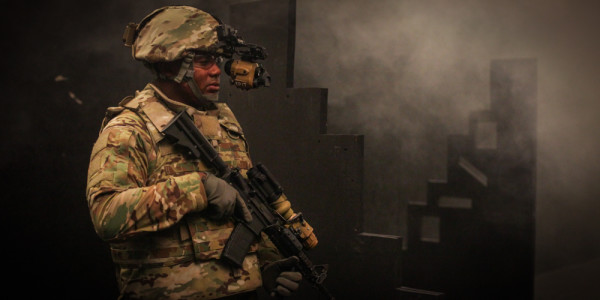

The objective of night vision technology, Army researchers wrote more than a half-century ago, is simple: “to make it possible for the soldier to operate at night with daytime flexibility and faculty.” That’s how the Army’s early night vision research was first described in September 1965 issue of Army Research and Development Newsmagazine — and with its next round of enhanced night vision goggles, the service is on the brink out blowing this decades-old objective out of the water.
The Army is finally preparing to field the new Enhanced Night Vision Goggle (ENVG) III to lucky soldiers this summer, the service announced on Monday. The third iteration of the program first initiated in 2002 (and showcased publicly in July 2017), the Army claims the ENVG III “can summon up a picture out of darkness in seconds, allows soldiers to see in two directions at once, and updates the image continuously as the Soldier moves.”

Two versions of the Enhanced Night Vision Goggle III from BAE Systems and DRS Technologies on display alongside the second the ENVG II and ENVG I.Task & Purpose photo by James Clark
The main advancement from the PVS-14 night vision monocular, traditionally used by soldiers, to the “enhanced versions” of night vision goggles is the addition of a second thermal-layer view, according to the Army. With the ENVG III, soldiers “have the option to fuse both kinds of vision into a single display or to look through the device in either mode by itself.”

One of the settings for the Enhanced Night Vision Goggle III outlines objects, making it easier to pick out targets.Task & Purpose photo by James Clark
Even more critically, night vision is now “untethered” from cumbersome goggles, applicable to a variety of optics systems. When wirelessly hooked up to the brand-new Family of Weapon Sights — Individual (FWS-I) rifle optics, the new goggles will effectively allow soldiers to peek and shoot around corners without exposing themselves to enemy fire.
“A soldier walking through a dark alley,” as the Army describes it, “can toggle between two crisp video feeds of who or what’s in front of him and what’s off to one side.”

Army Master Sgt. Lashon Wilson demonstrates the ENVG-III and FWS-I at an indoor shoot tunnel on July 27.Task & Purpose photo by James Clark
The Army claims that the new night vision goggles “give Soldiers capabilities considered impossible” in that 1965 newsletter. The service went so far as to invoke the classic maxim of the U.S. military’s pre-9/11 night vision dominance, coined by then-Secretary of the Navy John Lehman: “We own the night.” The latest night vision tech, with ”its emphasis on cutting through smoke, fog, and sandstorms,” the Army says, is now “on the cusp of letting Soldiers ‘own the environment.’”
RELATED: ‘WE OWN THE NIGHT’: THE RISE AND FALL OF THE US MILITARY’S NIGHT-VISION DOMINANCE »
Owning the environment is one thing, but owning the enemy is another entirely; deployed U.S. forces have increasingly spotted enemy jihadist fighters rocking night vision gear downrange. And it’s the good stuff. Last November, Taliban insurgents belonging to an elite “Red Unit” slaughtered scores of Afghan police officers while outfitted with sophisticated night-vision equipment; later that month, an ISIS sizzle reel showed a jihadi sniper and spotter team deploying a FLIR BHM thermal camera, originally designed to “help maritime vessels see debris, rocks, other boats and landmarks in pitch-black conditions,” as Army Times reported.
While Afghan security forces neutralized the head of the Taliban’s Red Unit with a well-placed strike the following month, the availability of night vision gear among jihadists continues apace. But if the ENVG III truly offers a night vision capability far beyond the Army’s current inventory, then a resurgence in the U.S. military’s night vision dominance may actually be on the horizon.
WATCH NEXT: